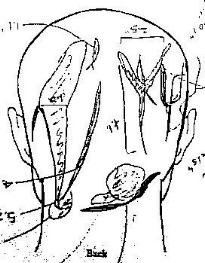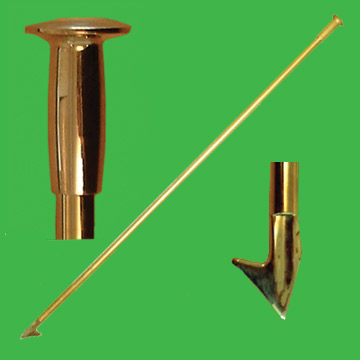|
"This is not a whodunit. If you find that it was murder, there's only one person who could have done it."
-- DA, Jim Hardin
"On the first day when we voted ... on one element, it was unanimous. It was not a fall. It was definitely a homicide."
-- Juror, Paul Harrison
"To me it is still a mystery."
-- Lestrade, about Kathleen Peterson's death
Everyone loves a mystery. Mysteries make for great television. But Kathleen Peterson's murder isn't a mystery.
Dr. Deborah Radisch, North Carolina's assistant medical examiner wasn't mystified. She told jurors what they already knew from viewing autopsy photos: Kathleen Peterson died "due to severe concussive injury of the brain caused by multiple blunt force impacts of the head."
Chief medical examiner, Dr. John Butts testified, "the multitude of injuries are not consistent with a fall down the steps," and flatly stated, "You don't just get lots and lots of lacerations across the back top of the head."
James McElhaney, emeritus professor of engineering at Duke University similarly testified to the obvious truth, "You can't hit the flat stair surface with the top of your head in a fall." McElhaney noted, "Two of the wounds could be attributed to contacting a horizontal edge like the stairs, but the others are in the wrong direction and start in the wrong place."
Without question, Kathleen Peterson's head violently contacted the stairs and surrounding walls, but her main injuries were caused by a very specific weapon. "A blunt instrument, most likely a rounded blunt instrument," said McElhaney. "A relatively light object striking the head."
Dr. Kenneth Snell saw Kathleen Peterson's body at the scene a few hours after police arrived.
Although he indicated "accident" on a preliminary report, Dr. Snell also decided an autopsy was necessary and advised police to begin looking for something like a crowbar or fireplace poker.
Snell testified that he saw two distinct lacerations that formed an avulsion, or tearing, of Kathleen Peterson's scalp, but that her hair was matted with blood.
"Since I couldn't see the rest of the back of the head, I informed the detectives they should look for some sort of instrument that could have created these lacerations should there be more lacerations once the rest of the back of the head could be examined," Snell said.
The next day, after viewing the autopsy and getting a close-up look at the victim's wounds at the morgue, Dr. Snell concluded Mrs. Peterson died "from an assault -- more specifically a beating." Snell cited extensive wounds to the body that included numerous bruises to Kathleen's face and the backs of her arms and hands.
Based on the exhaustive, 40-officer grid search, investigators knew the murder weapon was either extremely well hidden or had been quickly removed from the Peterson property. It was missing from the scene.
No one but Kathleen Peterson's killer will ever truly know what murder weapon was used, but police knew it was a fairly long, thin, rounded implement, but with at least one sharp edge. It tore into Mrs. Peterson's head so sharply, at places, the skin hangs open in flaps.

Police knew right away they were looking for something like a fireplace poker and, in an amazing coincidence, a poker was missing from the Peterson's fireplace.
The item strangely missing was the long, thin, hook-ended "blowpoke" that was given as a gift to Kathleen Peterson by her sister, Candace Zamperini, in 1984. The unusual 40" brass blowpoke is both a blower and a poker in one tool. Zamperini had given the identical gift to several family members. Its significance to family dynamics is obvious, and the poker was seen in the Peterson mansion for years.

"It was always in the kitchen," Zamperini testified, "I did use it on Thanksgiving in 1999. It was right next to the fireplace."
And yet by December 9, 2001 -- the blowpoke was gone.
Peterson's attorney David Rudolf did his own investigation, and during the trial, he took great pains to establish that the blowpoke was not in photos and home videos in the year prior to Kathleen Peterson's death. Rudolf showed that in place of Candace's poker was Kathleen Peterson's father's cane, which had apparently become a fireplace tool.
Prosecutor Jim Hardin agreed police never found a murder weapon, but told jurors the State could prove beyond a reasonable doubt that something fitting the description of the missing blowpoke is what killed Kathleen Peterson.
Shortly before the trial ended, David Rudolf entered a brass blowpoke into evidence, telling jurors it was accidentally found in Michael's basement by an unspecified person at an unspecified time. The jury paid little attention to Rudolf's blowpoke since it wasn't in the condition the bloodied and bent murder weapon would have been in. Rudolf on the other hand, thought the newly discovered poker was the central piece of evidence in Peterson's trial.
After his client was found guilty, Rudolf told reporters, "In my mind, when the prosecution spends three months telling the jury that your client beat somebody to death with a blowpoke, and you bring in the blowpoke, if that is not reasonable doubt, I don't know what reasonable doubt is."
Rudolf apparently did not think it doubtful that after spending months proving the blowpoke had not been in Peterson's home for years -- jurors would reasonably believe his astounding, last-minute proof that it had been overlooked while sitting in Peterson's basement the whole time.
Juror, David Heggins expressed his reasons for doubting the defense team's surprise blowpoke. In post-trial comments he said, "It was awful strange to us that five different detectives had gone through the basement looking for that exact thing and none of them found it -- then two or three months later, it was propped up against the wall."
With a total of 4 blowpokes entered into evidence, why Rudolf thought his fireplace tool was so special is a mystery. Even Michael -- at first anyway -- was strangely suspicious of the surprise poker. Jean-Xavier de Lestrade's cameras catch Peterson's guilty reaction to the finding -- he wanted to know if the blowpoke was bloody!
Years later, Jean-Xavier would try and explain the defendant's bizarre reaction by saying Peterson feared Durham investigators had purchased and prepared a blowpoke, smeared some of his wife's blood on it, snuck it into the basement and planted the fake murder weapon to be found by family members months later. The point of such a conspiracy isn't made clear since the State was going to trial with or without a weapon.

At any rate, in his only post conviction interview, Peterson concedes what Lestrade still refuses to admit: a person with a weapon -- some weapon -- killed Kathleen Peterson. Her death is not a mystery, it's a murder. Speaking from prison, Michael said:
"Well of course I thought, well, that's the only thing he's basing his case on is this blowpoke, and then it wasn't the blow poke -- so of course I thought, well for all of these other reasons including the fact that I certainly didn't kill Kathleen -- well, I certainly didn't kill her with the blowpoke -- so I thought of course, this solves the problem for the case. And then I find out it didn't even make any difference to the jury. Something else must have caused those injuries, but nobody knows what."
State's Evidence
|
 |

